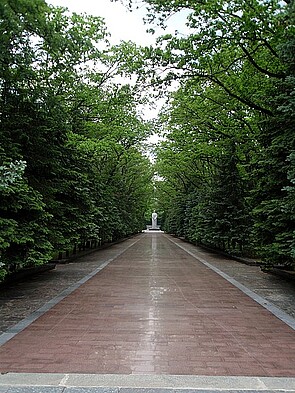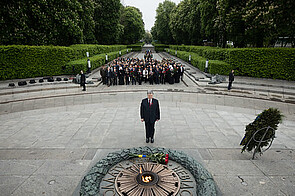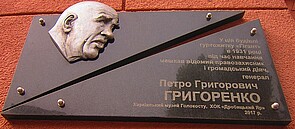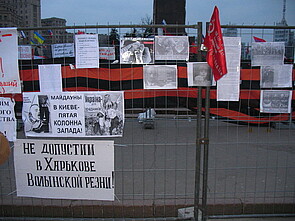31. Aug 2020 - DOI 10.25626/0120
Laura Eckl is a research assistant at the Chair for Modern European History, University of Wuppertal. Her dissertation focuses on the German occupation of Northeastern Ukraine during the Second World War, in particular on supply strategies of the occupied population in dealing with hunger and shortage. This is part of the international research project "Societies under German Occupation".
Jan C. Bever is a Kyiv-based consultant for the German development agency GIZ (Deutsche Gesellschaft für Internationale Zusammenarbeit). He holds an MA degree in East European Studies from Ludwig-Maximilians-Universität, Munich and his research focusses on Ukraine’s political system, post-Soviet patronal politics and informal economies.

On last year’s Victory Day, held on 9 May 2019, a brawl broke out at Kharkiv’s Memorial of Glory. The local daily, Kharkiv Today, reported that a handful of citizens quarrelled with each other after one group had been singing Soviet songs and saying slogans such as “Thank you grandpa for the victory”, and the other group sang about the controversial Ukrainian anti-Soviet nationalist, Stepan Bandera. Just like in other former western republics of the Soviet Union, a national debate about the memory and commemoration of the Second World War has long persisted also in Ukraine. An analysis of the local celebrations on 8/9 May will foster a better understanding of Ukrainian memory culture. Whilst Kharkiv (formerly Kharkov in Soviet times) is a predominately Russian-speaking city in the eastern part of the country, the city reflects all the contentious aspects surrounding these debates.[1]
Since 2015, Law no. 315-VІІІ “On Perpetuation of the Victory Over Nazism in World War II of 1939–1945” stipulates that Ukrainians celebrate the victory over Nazi Germany on two specific dates – the 8th and 9th May. Memorial day (on 8 May), was introduced only in 2015 in post-Maidan Ukraine as a “Day of Remembrance and Reconciliation” alongside the already existing “Day of the Victory over Nazi Germany in the Second World War of 1939–1941” on 9 May. Whereas the revolutionary moment of the 2014 Euromaidan protests may appear as a catalyst for celebrating the 8th of May and embracing the prominent date in Western European and Anglo-Saxon memory culture, the reason for having two different days actually dates back to 1945. When the German delegation signed a declaration of unconditional surrender at 11:01 pm on 8 May 1945 in the headquarters of the Red Army in Berlin-Karlshorst, it was 12:01 am and therefore 9 May in Moscow. The two dates, the 8th of May in Western European and Anglo-Saxon countries, and the 9th of May in the countries under Soviet influence, became universal symbols of the victory of the Allies over Nazi Germany.
In the Soviet Union 9 May first became an official state holiday under the leadership of Leonid Brezhnev on the 20th jubilee of the victory in 1965. From then on, ‘Victory Day’ (Den’ Popedy) grew to be an essential element of identity building by Soviet authorities. Large military parades and celebrations were held annually in the larger cities of the Soviet republics, which focused on a heroic, military-oriented commemoration of the end of the Second World War. Veterans became an integral aspect of the celebrations and, wearing their decorated uniforms, were invited as guests of honour. Additionally, monumental memorial building projects were erected up until the 1980s, for example the Motherland Monument in Soviet Kiev or the complex of the Memorial of Glory in Soviet Kharkov.[2]
Following independence in 1991, former Soviet Ukraine strived to develop a national way of commemorating the past; a task each president approached differently. At the turn of the millennium, the administration of former pro-Russian President, Leonid Kuchma (1994–2005) advocated to maintain the existing Soviet practices surrounding 9 May. After the Orange Revolution in 2004/05, President Victor Yushchenko (2005–2010) focused on the commemoration of the Great Famine of 1932/33 under Stalinist rule, known in Ukraine as Holodomor, to become the unifying experience of modern Ukraine. To foster coherent national memory, in 2006 Yushchenko also created the Ukrainian Institute of National Remembrance (UINP), a government controlled memory institute.[3]
Since the Euromaidan in 2014, the annexation of Crimea and the ongoing war in areas of Eastern Ukraine, the country’s lawmakers passed a set of so-called de-communization laws in 2015 to distance themselves from Soviet and contemporary Russian commemoration practices concerning the Second World War.[4] In April 2015, President Petro Poroshenko introduced the Day of Remembrance and Reconciliation, which is to be celebrated annually on 8 May to honour all victims of the Second World War; this was a shift in focus from the rather heroic, military-oriented commemoration of 9 May. The legal text no longer contains the Soviet phrase ‘Great Patriotic War of 1941–1945’, the term ‘Second World War of 1939–1945’ is used instead. Acknowledging that the Second World War began in 1939 is particularly important in Ukraine’s case. The Molotov-Ribbentrop Pact of 1939 and the subsequent Soviet annexations of the Baltic States, Eastern Poland, and parts of Romania – including the territories of today’s Western Ukraine – previously had no part in Soviet memory culture. In the Soviet narrative, the war was framed as the ‘Great Patriotic War’, which started on 22 June 1941 with the invasion of German troops. Post-Maidan lawmakers kept 9 May as ‘Victory Day over Nazism in the Second World War’ because a significant proportion of the population in Ukraine did not entirely want to part with commemoration practices from the past. Thus, 9 May continues to be celebrated as a national holiday.
The long-running Victory Day tradition of heroic commemoration, parades and gatherings in public spaces for one of Ukraine’s most popular holidays could not be followed this year. Due to COVID-19 restrictions, Kharkiv inhabitants were forbidden from attending large marches and events to comply with health and safety measures. Subsequently, social media became a pivotal instrument for the festivities. During quarantine, new forms of commemoration were spread in virtual space, on streaming platforms such as Facebook and YouTube, which included a larger number of people who were able to partake or spectate.Despite quarantine measures, there were still numerous physical places in Kharkiv that attracted citizens, politicians and members of civil society over the course of both days.
In one example that was particularly symbolic and removed from the heroism of the past, the members of the UINP’s regional office and of pro-European civil society conducted a minute of silence. The action was called the ‘First Minute of Peace’ and it was carried out at 11:01 pm on the city’s centrally located Freedom Square. Restricted in numbers by quarantine measures, a few dozen people lit candles and stood together in silence – amongst them, activists who participated in Kharkiv’s Maidan movement in 2013/2014. The organizers of this ceremony had intentionally chosen the tent used by the local volunteer battalions on the square as their location. Written on it was the slogan: “Everything for the Victory”. Since the Euromaidan, this had become a regular meeting place for Ukrainian voluntary fighters to gather support for the Ukrainian army and the voluntary battalions in Donbas and to commemorate the effort of the Euromaidan revolution of 2014. In a public speech, former Maidan coordinator and journalist Volodymyr Chystylin connected the commemoration initiative on 8 May 2020 to Ukraine’s current war by declaring that he hoped for good to overcome evil, for the war to end and that they would soon meet again in a new series of the “first minute of peace."[5]
Apart from the location, the symbols worn by all participants were in the spirit of the changes that occurred after Ukraine’s Euromaidan. Everyone wore red remembrance poppy pins, the new nationwide symbol of remembering the Second World War since the de-communization laws in 2015.[6] The poppy, originally a symbol in the Anglo-Saxon memory context, has become a popular symbol to remember the end of the war in Ukraine. It often appears with the official slogan: “1939–1945 Never again”. Following the example of previous governments, the current Zelenskyy-Shmyhal administration displayed the poppy nationwide on billboards and TV advertisements for the celebrations in 2020. On both days, public figures such as TV hosts, police officers or politicians wore poppy buttons on their shirts, dresses, and jackets. Included among them was President Volodymyr Zelenskyy during his video messages to the nation.
Tellingly, Kharkiv’s mayor Gennady Kernes, leader of the pro-Russian party Trust in Businesses (Doveray delam) and his local entourage did not wear a poppy pin during the celebrations on 9 May. Kernes has been an ambiguous figure in the Ukrainian political landscape. During the Euromaidan, he came under sharp criticism for his pro-Russian stances. Shortly after a brief hideout in Russia, Kernes survived an attempted assassination in Kyiv in spring 2014; he has been in a wheelchair ever since. His political narrative changed after the incident, trying to avoid an explicit pro-Russian stance. On Victory Day, Kernes, alongside other high-ranking politicians at the regional level and war veterans, lay red carnations and roses – flowers which were typical during Soviet times – in the complex of the Memorial of Glory.
The Memorial of Glory consists of a long tree-lined alley leading towards the Motherland Monument, next to it is the eternal flame of the unknown soldier. Adjacent stone tables are engraved with names of citizens and soldiers who were killed during the German occupation. It has traditionally been a central location for commemorating the Second World War in Kharkiv. On 8 May, Kharkiv citizens and local state representatives were seen throughout the day laying flowers at the memorial. Commemorations on this working day were quiet, the devout character of the location and the atmosphere fit the occasion of the Day of Remembrance and Reconciliation.
In contrast, over the course of Victory Day, the area was filled with crowds, despite quarantine measures and heavy rain. In the afternoon, participants of the pro-Russian movement Regiment of Victory gathered in front of the main monument of the memorial complex waving red flags with “75 years of the Great Victory” written on each, while broadcasting communist symbols by wearing red facemasks with a yellow star.
After the gathering in the park, an argument started between the participants of the Regiment of Victory group and the police over their use of communist symbols. Since 2015, Law no. 2558 of the de-communization laws prohibits the display of the Soviet Union’s symbols in Ukraine. Thousands of streets and entire cities were renamed in the aftermath, such as Dnipropetrovsk to Dnipro or Kirovohrad to Kropyvnytskyi, and symbols were removed from monuments. Thus, various symbols of the Red Army can no longer be shown during Victory Day without violating the law. Ever since the law came into force, police in Ukraine have confiscated numerous items, such as Soviet flags, or during 2020’s COVID-19 pandemic: red facemasks with yellow stars. A rather new memory symbol for the ‘Great Patriotic War of 1941–1945’ is the St. George’s ribbon. This Tsarist military award, which was adopted in Russia in 2005 has been worn on the Russian side in the context of the annexation of Crimea and the ongoing war in Donbas. Since 2017, the public display of it is prohibited by Ukrainian law.
A simple way to publicly show support for the celebrations of Victory Day and comply with social distancing rules was to take part in a motor rally while sitting in one’s own car. Officially, there were fifty registered motor rallies in various Ukrainian cities, making up 15 per cent of all registered ceremonies for 9 May.[7] Being mostly unimpressed with the reprimand by the police, some participants of the Regiment of Victory rally joined a motor rally shortly after the initial gathering, honking their way to Kharkiv’s city centre with red flags hanging out of their windows. Others, like the historical re-enactment organization Technical Club Samokhod, drew attention in the city and on social media channels such as YouTube for dressing up in historical uniforms – which included the aforementioned forbidden Soviet symbols – and driving through the city centre in wartime vehicles. Most notable, was a motor rally organized by the anti-establishment party of Ukrainian blogger Anatoliy Shariy. As documented in a short film posted on Youtube, the rally included approximately 250 cars, which began at 11 am from the memorial of Marshall Ivan Konev, a Soviet general of the Second World War, in the hills west of the city, and made its way to Constitution Square in the city centre.
Finally, Kharkiv received yet another place for future commemoration: via his facebook account, Mayor Kernes initiated the planting of ten oaks in the Shevchenko Park in the city centre “to commemorate those who did not return from the front”.
The fiercest and most revealing disputes about commemorating the Second World War revolve around who should or should not be remembered. The heroism of Red Army soldiers as liberators from the National Socialist occupation became a central element of celebrating 9 May. Both individual Soviet generals and common soldiers from personal family circles are traditionally honoured.
Before the de-communization laws in 2015, the focus on remembering military figures was an omnipresent aspect of the city’s landscape. Streets were named after Soviet generals, statues and monuments reminded citizens of military figures. After 2015, pulling down the Lenin Statue was only the beginning of the ongoing tension and dispute about the city’s memorial landscape, long celebrated heroes were becoming increasingly challenged.
Another effect of the 2015 de-communization laws involved the renaming of Marshal Zhukov Avenue after Petro Hryhorenko by the Kharkiv City Council in 2016. Zhukov is the most famous Soviet wartime general, celebrated by some as the greatest general of all time and condemned by others as a brutal butcher in the Soviet conquest of Eastern and Central Europe, as well as a dark accomplice of Stalin. Petro Hryhorenko was also a major general in the Red Army during the Second World War. However, in contrast to Zhukov he became a dissident in the 1960s, emigrated to the United States and joined the émigré Ukrainian Helsinki Group. This non-governmental human rights organization made it their mission to ensure that the Soviet government complied with human rights, as laid down in the Helsinki Accords of 1975.
To advocate for Soviet nostalgic sentiments in the wake of 2019’s Ukrainian parliamentary elections, Mayor Kernes shared an e-petition on 8 May 2019 to reinstate the street’s Soviet era name. When the petition reached the targeted number of signatures in June 2019, a group of activists reacted by destroying a bust of Zhukov in the centre of Kharkiv and raised a Ukrainian national flag in its place. The case went to court with the UINP acting as a plaintiff. On 5 September 2019, a regional court rejected the renaming of the street back into Zhukov’s name.[9] Just in time for the two May holidays in 2020, the UINP released a series of videos debunking Soviet myths – one of them listing the frauds of Marshal Zhukov.
Apart from the disputes about famous war heroes, the act of honouring the remaining, mainly geriatric, but widely respected veterans of the Second World War is challenged by only a few people. Paying tribute to veterans has a long tradition and is a competitive field amongst Ukrainian politicians. Politicians with pro-Russian stances have often criticized the de-communization laws of 2015 for supposedly disrespecting the achievements of veterans and elderly people in Ukraine. It came as no surprise that the pro-Russian politician Andry Lesyk, self-proclaimed protector of the Russian language in Kharkiv, gave a heated speech about remembering the heroism of Red Army soldiers while holding a picture of his great-grandfather at the Memorial of Glory on 9 May. Meanwhile, Volodymyr Kucher, governor of the Kharkiv region and representative of Ukraine’s pro-European president Zelenskyy, announced in late April 2020 that groups of the Kharkiv region who fought in the current or previous wars or suffered under the National Socialist regime as civilians would receive special payments. Veterans of the Second World War in the Kharkiv region were subsequently payed 2000 UAH (approximately 65€) each, which equals the amount of one month’s average pension in Ukraine.[10]
It is noteworthy that the administration statement explicitly listed “prisoners of concentration camps, ghettos and other places of forced detention, persons who were forcibly taken to forced labour” as recipients of these payments. Thus, persecuted groups, which had suffered extensively under National Socialist rule were considered (among them the Jewish and Roma population of Ukraine), to be Soviet prisoners of war and civilian forced labourers. During the German occupation, hundreds of thousands of Ukrainians, along with many other members of the Red Army, died in German captivity due to hunger, epidemics and maltreatment. Two million Soviet-Ukrainians were deported to Nazi Germany as forced labourers, so-called Ostarbeiter, and were ruthlessly exploited for the benefit of the German war economy. Estimates suggest that 1.6 million Ukrainian Jews were killed during the war. In Soviet-era Kharkov about 30,000 people were shot in the ravine of Drobytsky Yar in December 1941, among them 23,000 Jewish citizens.[11] After 1945, the Soviet government referred to Jewish victims of the Shoah as ‘Soviet’ victims. In today’s Ukraine, commemorating the Shoah has its place but is not a central part of the two days in May.[12]
Meanwhile on the municipal level, Mayor Kernes visited three veterans in their homes and offered them his gratitude for their services a few days prior to 9 May. On Victory Day, he shared a photo on his Facebook account of one of the two female veterans he visited, again expressing his gratitude. In addition, the official website of the city of Kharkiv reported about other politicians of the Kernes administration visiting veterans, giving out medals and allegedly monetary aid.
The war participants who have already passed away constitutes a third group of heroes that are being honoured. The public display of portraits of relatives who witnessed or fought during the Second World War is a practice that has been branded by the Immortal Regiment – a movement that began in Russia in the 2010s. Subsequently, this practice has also become popular in Ukraine amongst large parts of society. However, there has been a lot of criticism in recent years that the Immortal Regiment is a tool of Russian foreign policy rather than the sincere commemoration of loved ones. For example, in 2017, then president Petro Poroshenko called it a manipulation of people’s feelings after a march in Russia had included photographs of Russian soldiers and separatist fighters who fought in the current war in Donbas.[13]
Despite the controversy, Kernes had originally planned a march that he called the “Regiment of the Immortal Victory” from the centrally located Sumska Street to the Memorial of Glory on the outskirts of the city on 9 May. This idea fell through due to physical distancing precautions. Kernes tried to keep the symbolism of the concept alive by urging citizens to hold up the same photographs in their windows and balconies on 9 May at 12 pm. Again using his facebook account, he called for a citywide minute of silence, memory and gratitude. Kharkiv Today reported that Kernes even offered assistance to citizens for printing and framing personal photographs. The UINP did not object to the initiative but stressed the importance to avoid forbidden symbols, such as St. George’s ribbon.[14]
The 2015 de-communization laws have disconnected the war remembrance from the efforts of the Soviet Union and the Red Army and created a space for other forms of remembrance. As mentioned at the beginning of this article, during the clashes of 2019’s Victory Day local newspapers reported about fights between participants of the Immortal Regiment and Ukrainian nationalists who were shouting nationalist slogans about Stepan Bandera at the Memorial of Glory. Bandera was a prominent member of the former Organization of Ukrainian Nationalists (OUN), which was founded in 1929 on the grounds of anti-Soviet sentiments and the nationalist aspirations of Ukrainian independence. During the Second World War the OUN and its military arm, the Ukrainian Insurgent Army (UPA), cooperated with the German occupying power, also during pogroms against the Jewish population. Bandera and other members of the OUN had hoped the German occupiers would support their aspirations of independence – they did not.[15] In today’s Ukraine, large parts of nationalist circles glorify figures and symbols of the OUN and UPA. The crimes committed by the two Ukrainian nationalist organizations, for instance against the Jewish or Polish population in the regions of Volhynia and Galicia in 1942/1943 are not topics of critical debate.[16] One of the de-communization laws (No. 314-VІІІ) even protects the status of the two organizations and considers “public denial of the legitimacy of the struggle for independence of Ukraine in the twentieth century” to be “unlawful”.
In comparison to the year before, the scuffles with Ukrainian nationalists appeared only on the sidelines. As a small sign of protest, masked anti-Russian activists hung banners on three bridges along one of the motor rally’s route saying: “thank you grandpa for crushing the Moscow nit”, a wordplay on the popular Russian slogan “thank you grandpa for the victory”.[17]
This year’s celebrations on the 8th and 9th of May 2020 in Kharkiv reflect the ongoing debates about how to commemorate the Second World War in Ukraine. The Euromaidan in 2013/2014, the annexation of Crimea and the current war in Donbas have become critical junctures in Ukrainian memory culture. Ever since, Soviet and contemporary Russian commemoration practices are increasingly questioned, and memory laws have paved the way for new narratives.
The recent results of a nationwide survey, carried out by the Ilko Kucheriv Democratic Initiatives Foundation shortly before the 75th anniversary of the end of the Second World War in Ukraine, seems to sum up the divide in public opinion about the two dates. The survey asked citizens of Ukraine which date should be celebrated in May. Thirty-nine per cent were in favour of celebrating both 8 and 9 May. About a third of the participants thought that 9 May should be the only day for commemorating the Second World War, while only 14 per cent were in favour of celebrating 8 May.
Laura Eckl and Jan C. Bever: Ambivalent Memories: Commemorating 8 and 9 May in Kharkiv, Ukraine. In: Cultures of History Forum (29.08.2020), DOI: 10.25626/0120.
Copyright (c) 2020 by Imre Kertész Kolleg, all rights reserved. This work may be copied and redistributed for non-commercial, educational purposes, if permission is granted by the copyright holders. For permission please contact the editors.






Viktoriia Nechyporuk · 13.12.2024
A Trident on the Shield: Ukraine’s Decommunization Strategy and the Case of the “Mother Ukraine” Sta...
Read more
Alexandr Voronovici · 12.08.2023
Separatism and the Uses of the Past: Politics of History in the Self-Proclaimed Republics of Donbas
Read more
Jeremy Cohen · 25.01.2023
Vladimir versus Volodymyr: Conflicting Russian and Ukrainian Application of Rus’ Heritage
Read more
Andrii Nekoliak · 16.01.2020
Towards Liberal Memory Politics? Discussing Recent Changes at Ukraine’s Memory Institute
Read more
Alexandr Voronovici · 07.08.2018
At the Crossroads of "Memory Wars": Recent Debates on the Babi Yar Holocaust Memorial Center
Read more
Get this article as PDF download (including pictures).